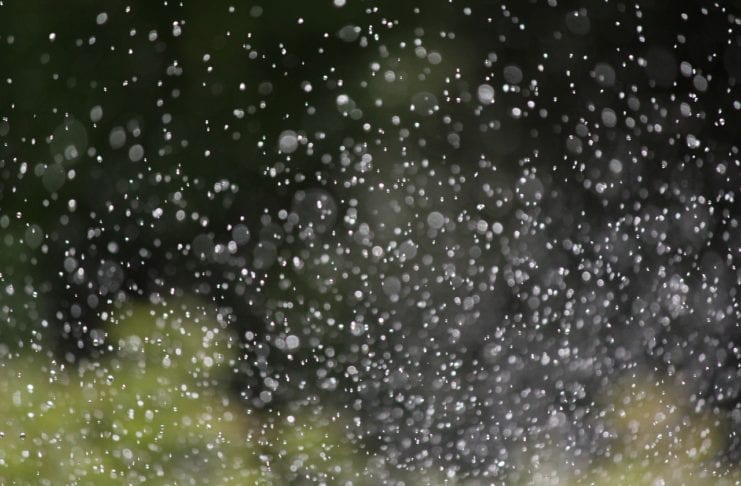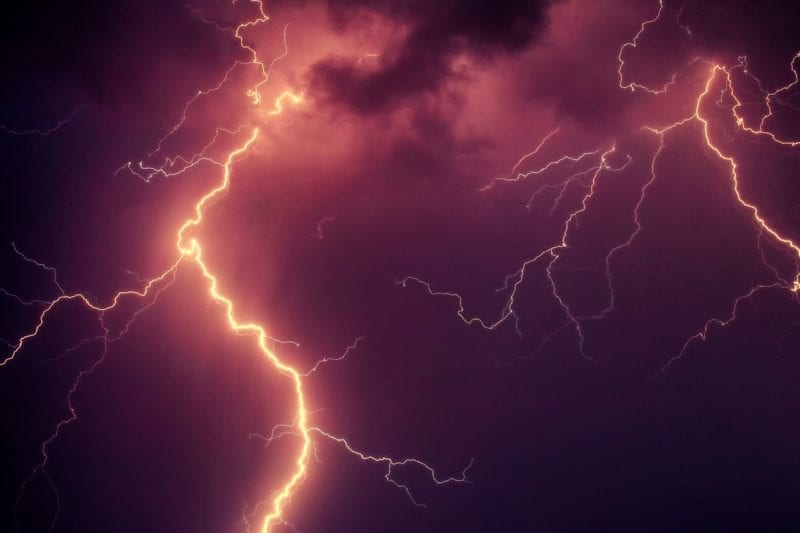The robotic mower should mow the lawn fully automatically and make your work easier. A big advantage is that this device can be operated even when you are not at home.
But what happens if you are not at home and a sudden change in weather. Will the robotic lawnmower be damaged if it rains and how can you protect it from the rain?

Here you can find out how dangerous sudden weather changes actually are for the robotic lawnmower.
Contents
Is the robotic lawnmower damaged by rain?
Light and normal rain should not be a problem for the robotic lawnmower. This can also perform its work during this weather without any problems. However, there may be problems with the quality of the cutting result if you leave the robotic lawnmower working unattended for a long time. On the underside of the robot, the grass may settle there and dry up after the rain. If the robotic lawnmower is used in the rain, you should clean it of the grass afterwards. The best way to do this is to spray the device with a hose.
The work is noticeably more threatening in the event of hail. The hailstones can hardly damage the housing of the robotic lawnmower, but the blades can be affected. If the robotic lawnmower drives over the lawn on which the hailstones have accumulated, the blades will bump against the massive grains. This can cause damage to both the motor and the blades.
Stronger hail can also damage the cover through which liquid enters the robot. The slight damage can cause moisture to get into the electronics and destroy the robotic lawnmower.
So in case of hail, always be careful and the robotic lawnmower should not do its work on the lawn in these weather conditions. Move the robotic lawnmower to a sheltered place or buy a small robotic lawnmower garage. With these precautions, you will prevent the robotic mower from taking damage from the rain and hail.
Another advantage of the robotic mower garage is that the device is protected from the hot midday sun. At the same time, you also protect the charging station from the weather. For better protection, you can reach for robotic mower garages from well-known manufacturers. These are tailored exactly to the robots and protect it effectively. Thus, this small additional investment is worth it if you want to enjoy the robotic mower for a long time.
How to deal with thunderstorms

In addition to the presented option to build a small garage, you should note that during thunderstorms can be a danger not only the rain. Because a lightning strike can quickly become the doom for your electronic devices.
If it starts to rain more heavily and lightning is also present, you should get the robotic lawnmower off the lawn and bring it into the dry. However, this does not mean that you have taken full precautions.
To prevent the charging station from being damaged in the event of a lightning strike, you should disconnect it from the power circuit. This also applies to the boundary wire and possible guide wires.
You should either protect the charging station with a small garage or bring it indoors as well.
You may not always be able to manually disconnect all the equipment from the circuit. You may not be home at the time or you may not always want to disconnect all electronic devices from the circuit.
In this case, you can use an outlet with integrated surge protection. This outlet will protect your electronics in case lightning should strike. While it must be mentioned here that this outlet does not provide 100 percent protection, in the unlikely event that lightning strikes your home, your electronic devices will be better protected.
What is a rain sensor
To better protect your robotic lawnmower from the rain, some units already have a built-in rain sensor. This sensor detects rain and passes this information to the robotic lawnmower. The robotic lawnmower then stops its work and goes to the charging station. In this way, robots can be protected that do not have a rainproof housing. Even though light rain should not be a major threat for most devices, there are still robotic mowers whose casing is not waterproof.
If the robotic lawnmower is already in the charging station and it notices the rain, it will stay in the charging station until the weather improves. If you live in a region where drizzle is frequent and you do not want the robotic lawnmower to stop working every time, then you can set the sensitivity of the rain sensor. Thus, it is possible to determine for yourself what amount of rain the robotic lawnmower should tolerate.
Especially for older and heavy models, the rain sensor is a useful addition. Although these robotic mowers drive over the lawn, they only flatten it instead of cutting it. Steep passages become real traps and the robot is at risk of falling by the wayside.
So the rain sensor is a useful feature of many robotic mowers. However, you need to pay close attention to whether your model also has this sensor, because it is not built into all products as standard.
How does the weather timer work
Another feature is offered with the weather timer. This is a function that independently determines whether the lawn needs to be mowed or not. If the lawn has barely grown, the robotic lawnmower skips the next mowing time and waits to mow.
In summer and autumn, this function is useful because the lawn may hardly grow in dry conditions. To determine whether the lawn needs mowing, the robotic lawnmower first begins its work and leaves the charging station. However, if the robot notices that the resistance is too small, then it can decide for itself that the lawn will still be too short. It then returns to the charging station and ventures the next attempt at the following mowing time. Thanks to this function, the lawn is only mowed when it is really needed. This protects the lawn and prevents the formation of tracks or damage to the lawn.
However, the name causes confusion. Because you may have hoped that the weather timer can also protect the robotic mower from rain. As you could learn with this explanation, the weather timer has only indirectly something to do with the rain and is not an effective protection.
The useful weather forecast
The weather can be predicted very accurately for a limited period of time thanks to modern technology. The supplier of robotic mowers, Bosch, takes advantage of this. It offers a Smart Gardening app that works in conjunction with the robots. With the help of this app, the robot automatically determines when the best time is for the next mowing operation. To determine this time, it evaluates the temperature and precipitation. As a user, you can now determine whether the robotic mower should rather stay in the charging station in bad weather.
Other manufacturers are currently still somewhat hesitant to install similar technologies in their robotic mowers. However, you can build an intelligent control yourself with a rain sensor from Loxone. However, you should already be a bit more versed in dealing with technology.
You can find the instructions for installing a rain sensor on the Technikblog.ch. Until the other manufacturers equip their robotic mowers with a rain sensor, this is an alternative for all skilled hobbyists.
What to do in case of damage
The purchase of a robotic mower is not exactly a cheap venture. A robotic mower with GPS can cost over 2,000 euros and a robotic mower without a boundary wire can cost around 1,000 euros. If this expensive device is damaged, you should carefully consider how to proceed in case of damage.
Like all appliances in the household, the robotic lawnmower also falls within the scope of household insurance. Here you need to check carefully whether the robotic lawnmower is also covered by your policy.
Often, protection is not provided for overvoltage damage. So if there is a lightning strike and the circuit is overloaded, the robotic lawnmower is not insured in most cases. Here, you should install the power outlet with surge protection as a protective mechanism. In addition, you can subsequently book the protection against overvoltage damage.
Another restriction is for items that can be stolen very easily. In the garden, the robotic mower is basically one of the objects that are very easy to steal. Since this also applies to many garden furniture and equipment in the garden, these are usually specified individually in the contracts. Thus, the garden furniture is insured even though it is easy to steal.
Annoyingly, the robotic mower is not included under these exclusions. Here you need to explicitly state that the robotic mower should also benefit from the protection.
If you are unsure and would like to have the robotic mower covered by the insurance in any case, you should contact your insurance company and describe the case. This way, you can check if the robotic mower is included in the coverage or if you still need to add it.
Conclusion
Whether the rain will harm your robotic garden mower depends primarily on the model. Most robots have a waterproof housing that can withstand light rain. Still, mowing in the rain is not ideal, as lots of grass will get caught on the underside and dry up. With models that are not waterproof, you should logically refrain from mowing in the rain.
In any case, mowing in hail is harmful. The hailstones can damage the blades and cause severe damage. The housing can also suffer from larger hailstones. In any case, it is not advisable to operate the robotic lawnmower in hail.
Depending on the model, you can also use a rain sensor, which independently determines whether it is currently raining in the garden and it would be better to drive the robotic mower to the charging station. A small garage for the robotic lawnmower and the charging station provides good protection.
In addition, you should ask your homeowner’s insurance if it already includes your robotic lawnmower.
This way, you are optimally protected against damage and even in the event of damage, the insurance company can help.

